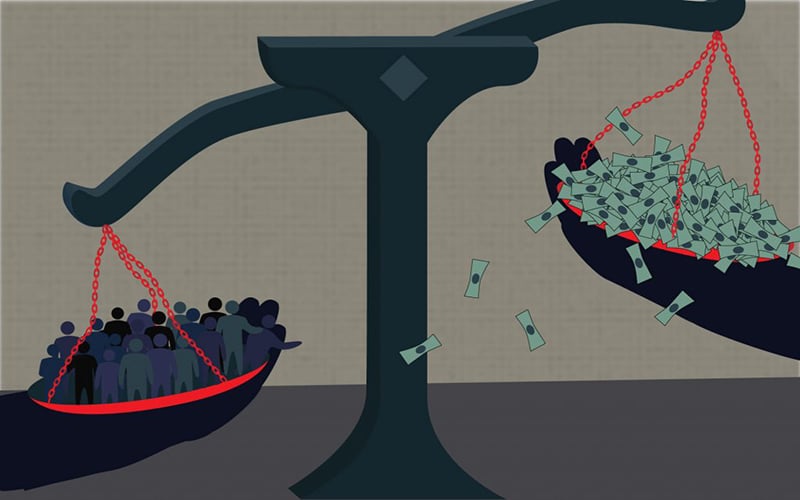
(Illustration by Zachary Van Arsdale/News21)
Timothy Smeeding began his research career in public affairs and economics by sitting across from the woman who created the official poverty measure of the United States – a standard he’s worked most of his career to change.
The stakes are high. The poverty line directs tens of billions of dollars annually in aid to the nation’s poorest people – for public housing, subsidized rent, food stamps, free school lunches, college grants, Medicaid and federal grants to nonprofits that serve low income communities.
But the equation used to set the poverty line hasn’t been updated since the 1960s. Consider 1967: The annual median income was $7,143; the median rent was less than $100 per month; and a gallon of gas cost 31 cents. A year at the University of Pennsylvania was less than $2,000.
“The official poverty measure was something that we created 70, 65 years ago, and it was appropriate for that time and period. But it isn’t anymore,” said Smeeding, a professor at Robert M. La Follette School of Public Affairs at the University of Wisconsin-Madison.
Most expenses, such as housing, fuel and college tuition, have skyrocketed. But the cost of food – which the poverty measure was mainly based on – has become cheaper because of better farming practices and more efficient supply chains.
Choosing measurements based on current realities
The federal government determines who is in poverty based on the cost of food to sustain a household, adjusted by the number of people in a family. Today, a family of four falls into poverty based on an annual household income of $26,500.
Economists who study poverty and inequality said the measure is outdated and may leave behind millions of people who might be eligible for assistance.
“If we were going to kind of have a more realistic measure, I think it would probably show that instead of 10% of kids roughly being under or near the poverty line, it would be more like 20%,” said Shawn Fremstad, a senior fellow who studies poverty and income inequality at the Center for Economic Policy and Research in Washington, D.C.
Shailly Gupta Barnes, policy director for the Kairos Center, a social equity and antipoverty group in New York, said the formula doesn’t effectively serve low-income communities.
“It was evident that of the measures that we had, the programs that were pegged to it were not sufficiently meeting the need that we saw,” said Barnes, who also works with the nonprofit Poor People’s Campaign. “It was very evident that the scale of poverty and economic insecurity was much, much greater than what has ever been accounted for.”
She said 4 out of 10 people in the U.S. “are one emergency away from economic ruin.”
But an adjustment to more accurately capture poverty in the U.S. also would balloon the costs of programs for food and rent assistance, health care and other government aid programs.
The budget for Medicaid, which provides free or low-cost health care to some people with low incomes, was more than $450 billion in 2020, according to the Office of Management and Budget. And the budget for the Supplemental Nutrition Assistance Program, or SNAP, which distributes benefits once known as food stamps, is more than $100 billion, according to the Congressional Budget Office.
Smeeding said the poverty line issue is further complicated because such government assistance doesn’t consider the financial benefits already provided to the poorest families in the form of SNAP benefits and tax refunds that aren’t considered income.
“You need some measure that takes account of the programs that you’re using,” he said.
By continuing to use an archaic poverty measure, Smeeding said, it’s not possible to see the impact of SNAP, Medicaid and other government assistance programs.
And the impact of the poverty line goes beyond money, Smeeding said.
“In effect, it has a role to play in public debate and public understanding,” he said, by shaping the understanding of what poverty is and how prevalent it is.
Better measurements
The Orshansky poverty measure – the name of the current official threshold – isn’t the only way to set the poverty line.
Fremstad recommends the U.S. follow the model used by many European countries: a relative poverty measure. There, the poverty line is anywhere from 40% to 70% of the median household income.
For example, if the median household income in France is $50,000 and the poverty line is set at 50% of the median, households making less than $25,000 would be considered in poverty.
Smeeding said the cost of living in different parts of the U.S. should factor into any measure on poverty; what $1,000 buys in Billings, Montana, does not go nearly as far in San Francisco. A more accurate poverty measure also should factor in the cost of housing, education and child care, he said.
“Most people think that those needs should somehow change with living standards,” Smeeding said.
Many state and local jurisdictions have “largely stopped using the poverty line to determine eligibility for social programs,” according to Stanford Social Innovation Review. Instead, local governments often
set program eligibility at a percentage of the federal poverty line. In Arizona, the state has its own measurements for some of its programs, including cash assistance.
Researcher meets the poverty-line originator
These measures rose in the early 1960s, Smeeding said, when the Kennedy administration acted to help families making less than $3,000 per year. However, the $3,000 was an arbitrary figure.
An economist on Kennedy’s Council of Economic Advisers suggested creating a more systematic approach to identifying and measuring poverty. The job was handed to Mollie Orshansky, a social science research analyst in the Office of Research and Statistics at the Social Security Administration.
Her goal: devise a system that would create a fair and accurate measurement of poverty in the U.S. that could be applied to a country of 180 million people.
The data available to Orshansky in the mid-1960s was a fraction of what is available today. But using data from the Department of Agriculture and studies on nutritionally adequate diets, Orshansky developed conclusions to calculate a poverty threshold.
Discovering that most nonfarm families at the time spent one-third of their income on food, she used the family food budget to calculate the poverty threshold, giving the federal government a widely applicable and systematic approach for the first time. Orshansky’s measure was adopted in 1969.
The Orshansky Poverty Thresholds are documented on the Social Security Administration’s website, and Orshansky, who died in 2007, has a Wikipedia page dedicated to her work.
In the 1970s, Smeeding said, a few small voices wanted the poverty measure to reflect a more holistic view of a changing economy. He was one of them.
In 1972 – while sharing an office with Orshansky at the Social Security Administration – Smeeding wrote his Ph.D. dissertation for the University of Wisconsin-Madison, saying there were flaws in the Orshansky Poverty Thresholds. He and Orshansky talked about the poverty line standard, he said, adding that she didn’t agree with his conclusions but always treated him courteously.
“I accepted her poverty line. I just said that the income measure, the resource measure, needed to be changed to reflect taxes and benefits,” Smeeding recalled. “I once told Congress that if Molly invented her poverty line after the Civil War, we’d be laughing at it.”
When Orshansky’s model began guiding U.S. policy more than five decades ago, the American economy was heavily based on manufacturing and agriculture, Smeeding said, but now it’s driven by technology and information.
Fremstad and Smeeding said policy creators need to keep Orshanky’s original intention in mind – to accurately pinpoint poverty.
That means throwing out a six-decade-old standard.
“The inability to measure poverty accurately reflects an inability of our society to address problems of need and want sufficiently,” Barnes said. “And that’s not the kind of society that any of us need.”
This story was produced in collaboration with the Walter Cronkite School-based Carnegie-Knight News21 “Unmasking America,” a national reporting project on the lingering toll of COVID-19 scheduled for publication in August. Check out the project’s blog.

